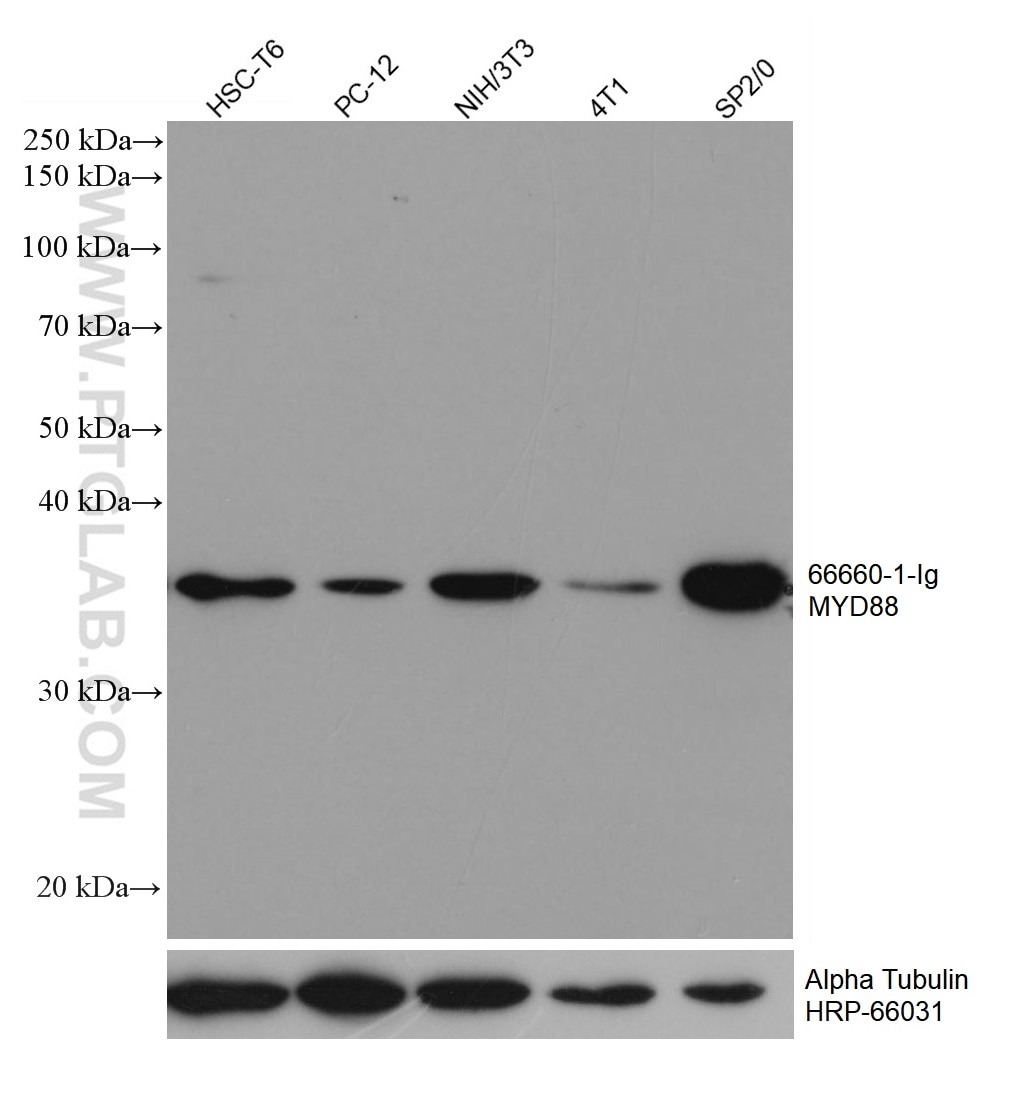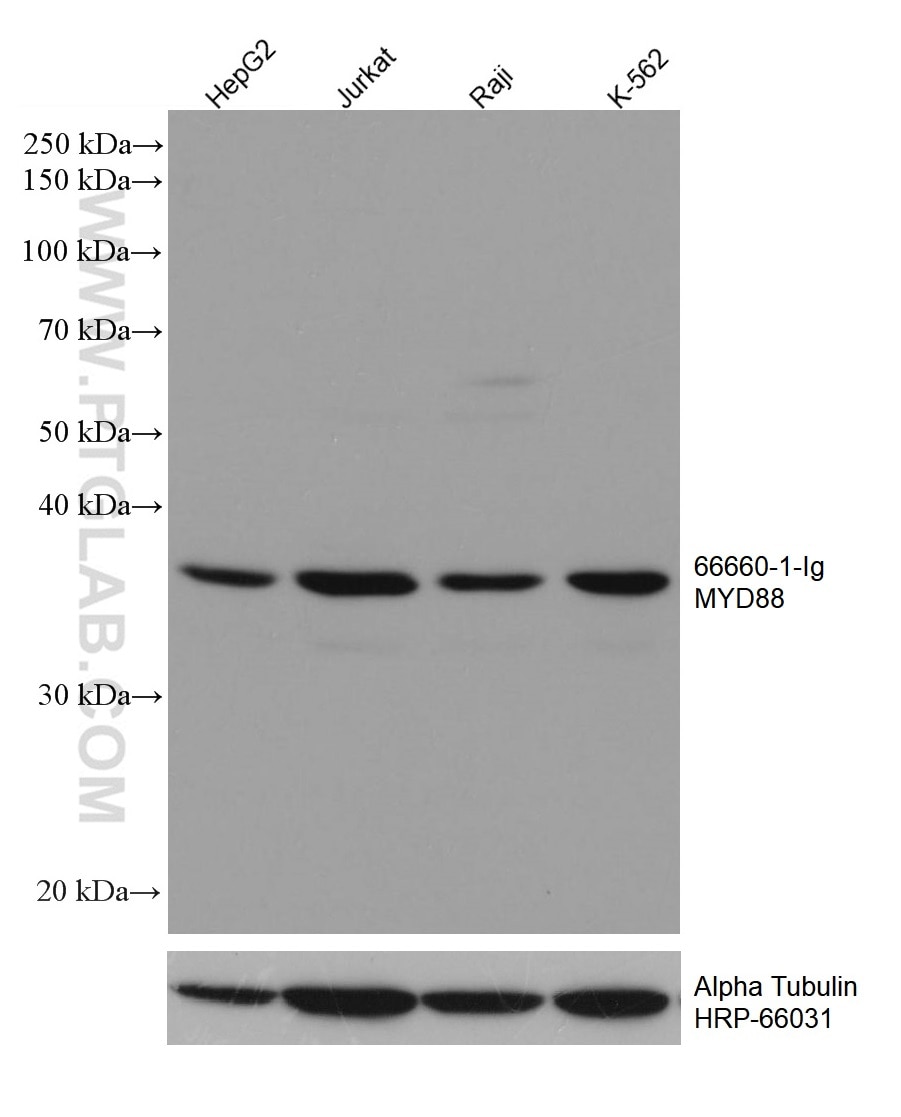Anticorps Monoclonal anti-MYD88
MYD88 Monoclonal Antibody for WB, ELISA
Hôte / Isotype
Mouse / IgG1
Réactivité testée
Humain, rat, souris
Applications
WB, IHC, ELISA
Conjugaison
Non conjugué
CloneNo.
1B10E12
N° de cat : 66660-1-Ig
Synonymes
Galerie de données de validation
Applications testées
| Résultats positifs en WB | cellules HSC-T6, cellules 4T1, cellules HepG2, cellules NIH/3T3, cellules PC-12, cellules Sp2/0 |
Dilution recommandée
| Application | Dilution |
|---|---|
| Western Blot (WB) | WB : 1:2000-1:10000 |
| It is recommended that this reagent should be titrated in each testing system to obtain optimal results. | |
| Sample-dependent, check data in validation data gallery | |
Applications publiées
| WB | See 9 publications below |
| IHC | See 1 publications below |
Informations sur le produit
66660-1-Ig cible MYD88 dans les applications de WB, IHC, ELISA et montre une réactivité avec des échantillons Humain, rat, souris
| Réactivité | Humain, rat, souris |
| Réactivité citée | Humain, souris |
| Hôte / Isotype | Mouse / IgG1 |
| Clonalité | Monoclonal |
| Type | Anticorps |
| Immunogène | MYD88 Protéine recombinante Ag19770 |
| Nom complet | myeloid differentiation primary response gene (88) |
| Masse moléculaire calculée | 33 kDa |
| Poids moléculaire observé | 33-36 kDa |
| Numéro d’acquisition GenBank | BC013589 |
| Symbole du gène | MYD88 |
| Identification du gène (NCBI) | 4615 |
| Conjugaison | Non conjugué |
| Forme | Liquide |
| Méthode de purification | Purification par protéine G |
| Tampon de stockage | PBS with 0.02% sodium azide and 50% glycerol |
| Conditions de stockage | Stocker à -20°C. Stable pendant un an après l'expédition. L'aliquotage n'est pas nécessaire pour le stockage à -20oC Les 20ul contiennent 0,1% de BSA. |
Informations générales
Background
Myeloid differentiation primary response 88 (MYD88) is an adapter protein critical to the innate and adaptive immune response.
What is the molecular weight of MYD88?
The molecular weight of MYD88 is 33 kDa.
What is the cellular localization of MYD88?
The subcellular localization of MYD88 is largely confined to the cytoplasm as condensed forms or aggregated structures.
What is the role of MYD88 in the IL-1R signaling pathway?
MYD88 plays a major role in the inflammatory signaling pathways downstream of Toll-like receptor (TLR) and interleukin-1 receptor (IL-1R) families. MYD88 links these receptors to IL-1R-associated kinases (IRAK), such as IRAK1 and IRAK2, via protein-protein interactions. The C-terminal TIR domain of MYD88 mediates the interaction with the receptors, whereas the N-terminal death domain of MYD88 associates with IRAK family members (PMID: 25580251). MYD88 acts via its intermediate domain to phosphorylate and thus activate IRAK1, IRAK2, IRF7, and TRAF6 to trigger NF-kappa-B signaling and cytokine secretion as part of the inflammatory response (PMID: 19679662).
What is MYD88's involvement in disease?
Defects in MYD88 due to deficiency of the protein leads to recurrent pyogenic bacterial infections, including invasive pneumococcal disease. Patients usually die between 1 and 11 months of age, but surviving patients are otherwise healthy with normal resistance to other microbes (PMID: 18669862). Mutations in the MYD88 gene also lead to the development of cancers such as lymphoma (PMID: 21179087) and some autoimmune disorders like ulcerative colitis (PMID: 24189845).
Protocole
| Product Specific Protocols | |
|---|---|
| WB protocol for MYD88 antibody 66660-1-Ig | Download protocol |
| Standard Protocols | |
|---|---|
| Click here to view our Standard Protocols |
Publications
| Species | Application | Title |
|---|---|---|
ACS Nano Bacteria-Anchoring Hybrid Liposome Capable of Absorbing Multiple Toxins for Antivirulence Therapy of Escherichia coli Infection. | ||
Theranostics Fibrinogen-like protein 2 aggravates nonalcoholic steatohepatitis via interaction with TLR4, eliciting inflammation in macrophages and inducing hepatic lipid metabolism disorder. | ||
Food Funct Salvianolic acid B prevents body weight gain and regulates gut microbiota and LPS/TLR4 signaling pathway in high-fat diet-induced obese mice. | ||
Pharm Biol Catalpol relieved angiotensin II-induced blood–brain barrier destruction via inhibiting the TLR4 pathway in brain endothelial cells | ||
Life Sci Salvianolate reduces neuronal apoptosis by suppressing OGD-induced microglial activation. | ||



